Acute Care Nursing: Assignment
VerifiedAdded on 2021/05/30
|9
|2541
|32
AI Summary
Contribute Materials
Your contribution can guide someone’s learning journey. Share your
documents today.
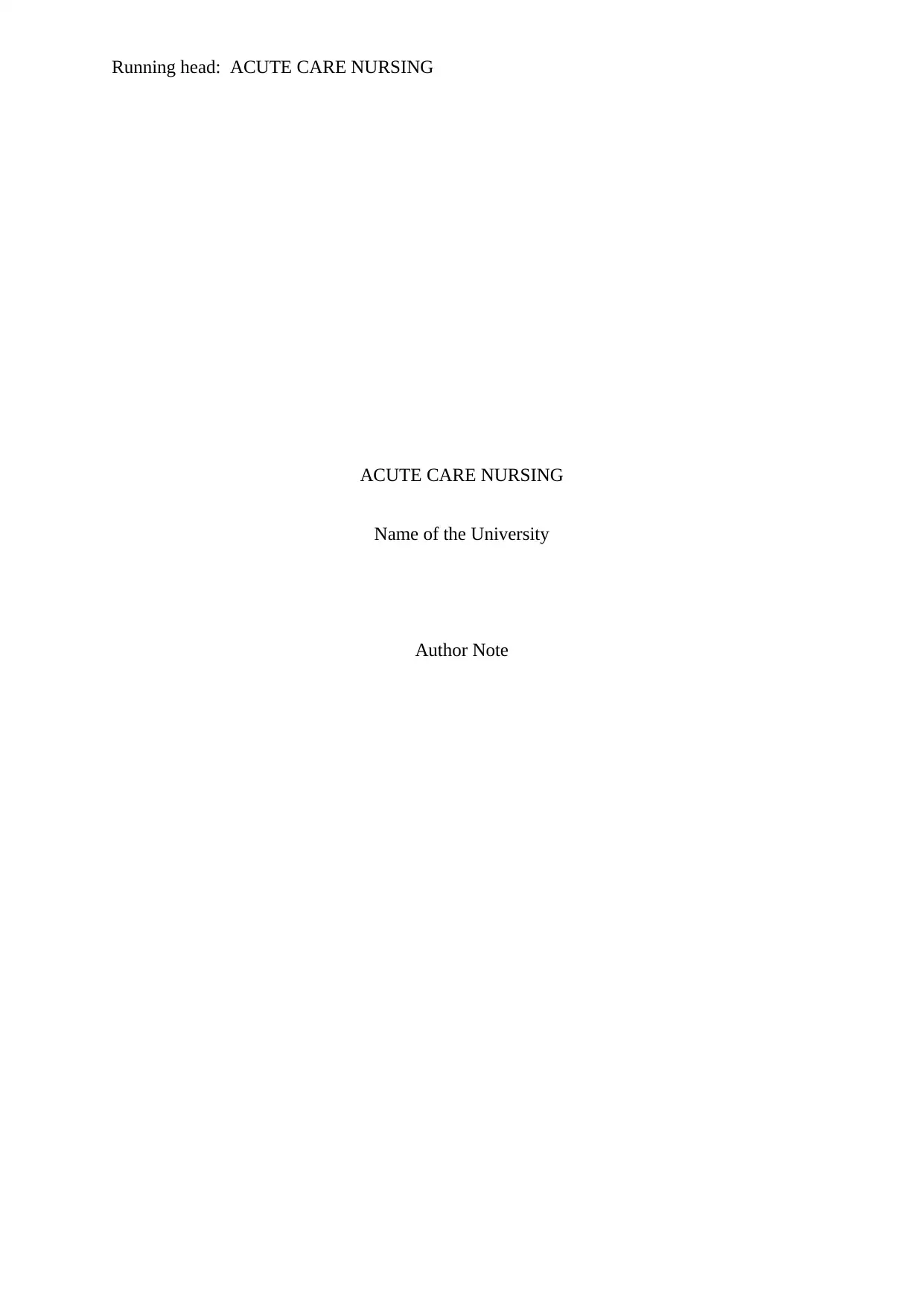
Running head: ACUTE CARE NURSING
ACUTE CARE NURSING
Name of the University
Author Note
ACUTE CARE NURSING
Name of the University
Author Note
Secure Best Marks with AI Grader
Need help grading? Try our AI Grader for instant feedback on your assignments.
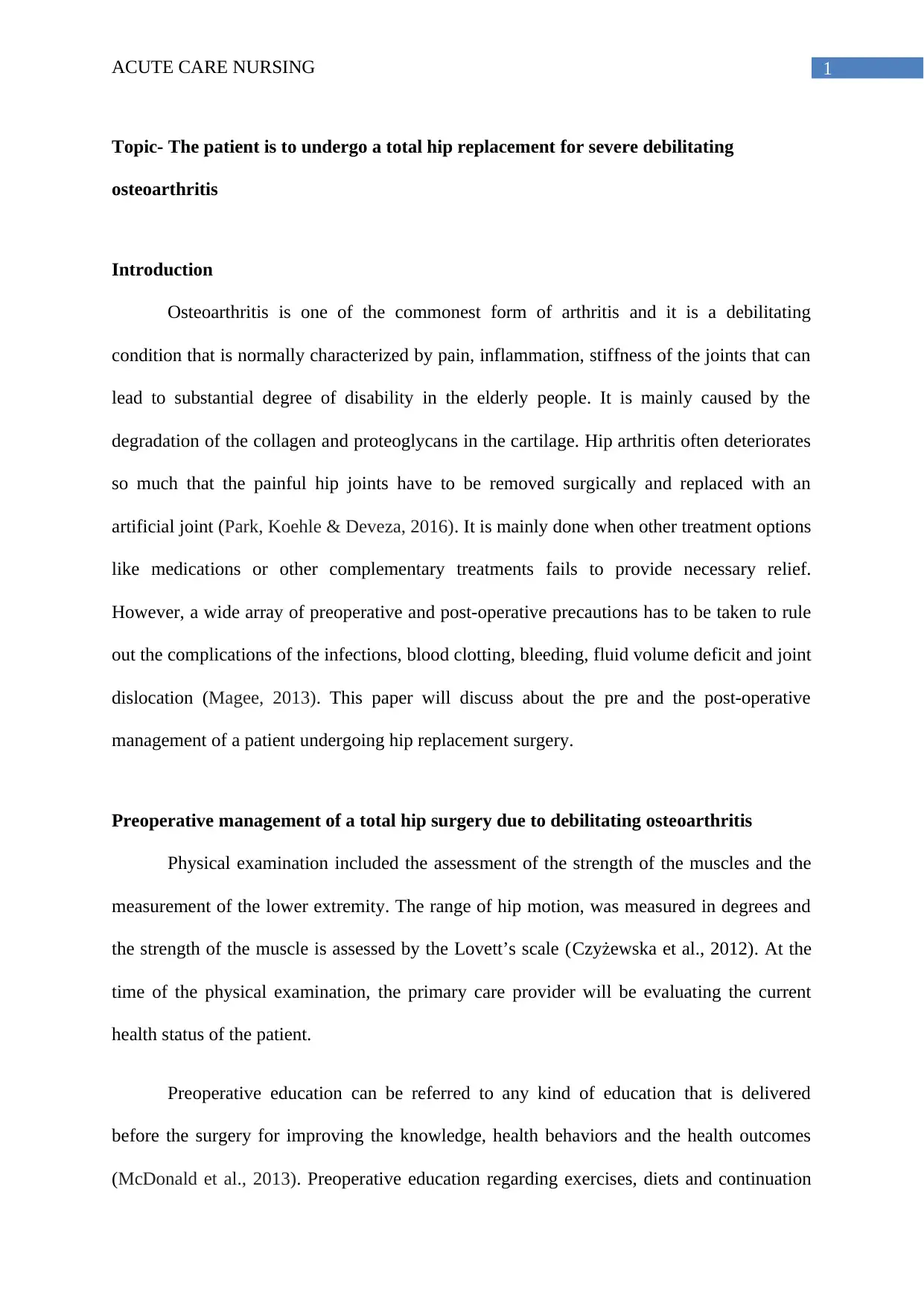
1ACUTE CARE NURSING
Topic- The patient is to undergo a total hip replacement for severe debilitating
osteoarthritis
Introduction
Osteoarthritis is one of the commonest form of arthritis and it is a debilitating
condition that is normally characterized by pain, inflammation, stiffness of the joints that can
lead to substantial degree of disability in the elderly people. It is mainly caused by the
degradation of the collagen and proteoglycans in the cartilage. Hip arthritis often deteriorates
so much that the painful hip joints have to be removed surgically and replaced with an
artificial joint (Park, Koehle & Deveza, 2016). It is mainly done when other treatment options
like medications or other complementary treatments fails to provide necessary relief.
However, a wide array of preoperative and post-operative precautions has to be taken to rule
out the complications of the infections, blood clotting, bleeding, fluid volume deficit and joint
dislocation (Magee, 2013). This paper will discuss about the pre and the post-operative
management of a patient undergoing hip replacement surgery.
Preoperative management of a total hip surgery due to debilitating osteoarthritis
Physical examination included the assessment of the strength of the muscles and the
measurement of the lower extremity. The range of hip motion, was measured in degrees and
the strength of the muscle is assessed by the Lovett’s scale (Czyżewska et al., 2012). At the
time of the physical examination, the primary care provider will be evaluating the current
health status of the patient.
Preoperative education can be referred to any kind of education that is delivered
before the surgery for improving the knowledge, health behaviors and the health outcomes
(McDonald et al., 2013). Preoperative education regarding exercises, diets and continuation
Topic- The patient is to undergo a total hip replacement for severe debilitating
osteoarthritis
Introduction
Osteoarthritis is one of the commonest form of arthritis and it is a debilitating
condition that is normally characterized by pain, inflammation, stiffness of the joints that can
lead to substantial degree of disability in the elderly people. It is mainly caused by the
degradation of the collagen and proteoglycans in the cartilage. Hip arthritis often deteriorates
so much that the painful hip joints have to be removed surgically and replaced with an
artificial joint (Park, Koehle & Deveza, 2016). It is mainly done when other treatment options
like medications or other complementary treatments fails to provide necessary relief.
However, a wide array of preoperative and post-operative precautions has to be taken to rule
out the complications of the infections, blood clotting, bleeding, fluid volume deficit and joint
dislocation (Magee, 2013). This paper will discuss about the pre and the post-operative
management of a patient undergoing hip replacement surgery.
Preoperative management of a total hip surgery due to debilitating osteoarthritis
Physical examination included the assessment of the strength of the muscles and the
measurement of the lower extremity. The range of hip motion, was measured in degrees and
the strength of the muscle is assessed by the Lovett’s scale (Czyżewska et al., 2012). At the
time of the physical examination, the primary care provider will be evaluating the current
health status of the patient.
Preoperative education can be referred to any kind of education that is delivered
before the surgery for improving the knowledge, health behaviors and the health outcomes
(McDonald et al., 2013). Preoperative education regarding exercises, diets and continuation
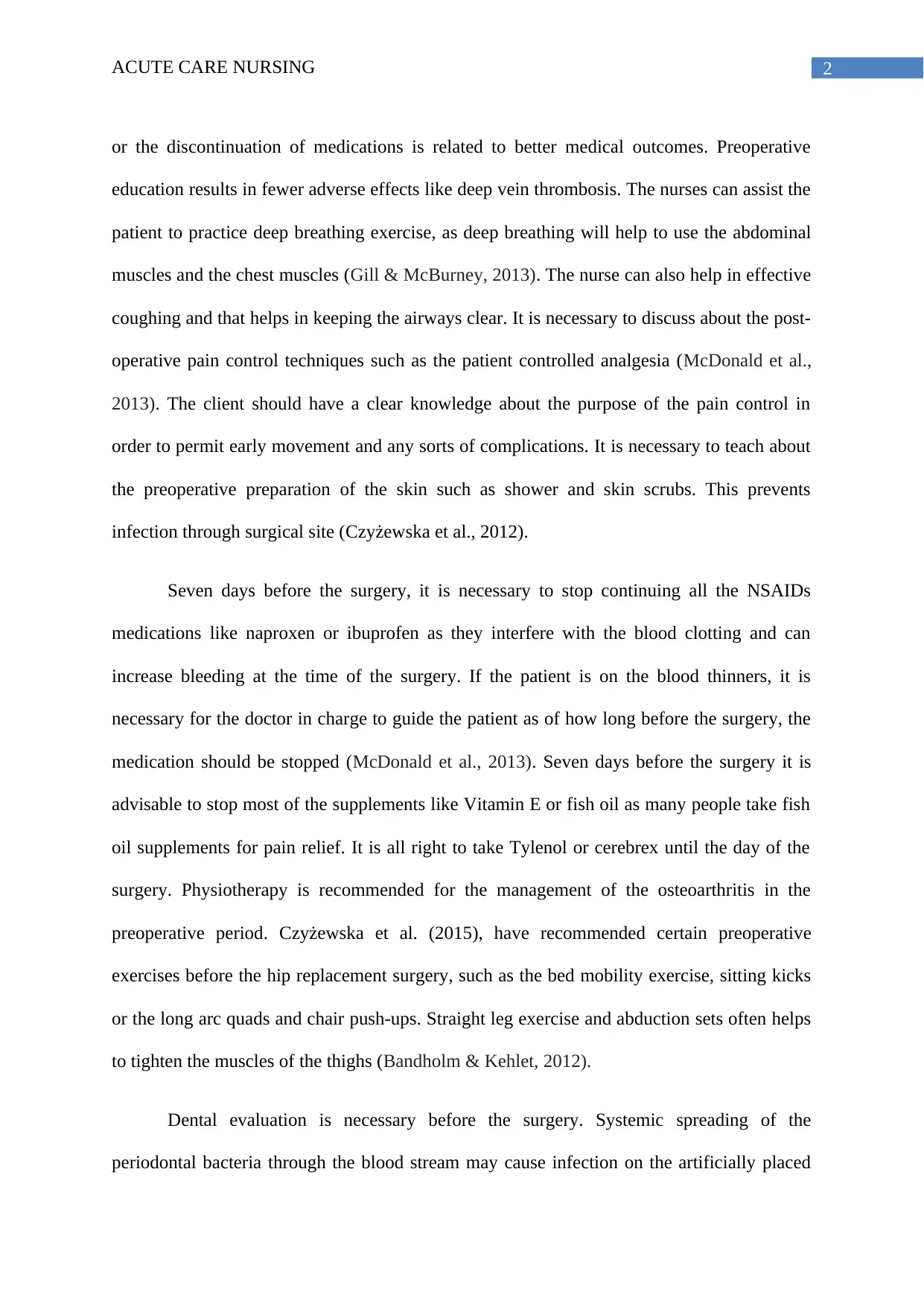
2ACUTE CARE NURSING
or the discontinuation of medications is related to better medical outcomes. Preoperative
education results in fewer adverse effects like deep vein thrombosis. The nurses can assist the
patient to practice deep breathing exercise, as deep breathing will help to use the abdominal
muscles and the chest muscles (Gill & McBurney, 2013). The nurse can also help in effective
coughing and that helps in keeping the airways clear. It is necessary to discuss about the post-
operative pain control techniques such as the patient controlled analgesia (McDonald et al.,
2013). The client should have a clear knowledge about the purpose of the pain control in
order to permit early movement and any sorts of complications. It is necessary to teach about
the preoperative preparation of the skin such as shower and skin scrubs. This prevents
infection through surgical site (Czyżewska et al., 2012).
Seven days before the surgery, it is necessary to stop continuing all the NSAIDs
medications like naproxen or ibuprofen as they interfere with the blood clotting and can
increase bleeding at the time of the surgery. If the patient is on the blood thinners, it is
necessary for the doctor in charge to guide the patient as of how long before the surgery, the
medication should be stopped (McDonald et al., 2013). Seven days before the surgery it is
advisable to stop most of the supplements like Vitamin E or fish oil as many people take fish
oil supplements for pain relief. It is all right to take Tylenol or cerebrex until the day of the
surgery. Physiotherapy is recommended for the management of the osteoarthritis in the
preoperative period. Czyżewska et al. (2015), have recommended certain preoperative
exercises before the hip replacement surgery, such as the bed mobility exercise, sitting kicks
or the long arc quads and chair push-ups. Straight leg exercise and abduction sets often helps
to tighten the muscles of the thighs (Bandholm & Kehlet, 2012).
Dental evaluation is necessary before the surgery. Systemic spreading of the
periodontal bacteria through the blood stream may cause infection on the artificially placed
or the discontinuation of medications is related to better medical outcomes. Preoperative
education results in fewer adverse effects like deep vein thrombosis. The nurses can assist the
patient to practice deep breathing exercise, as deep breathing will help to use the abdominal
muscles and the chest muscles (Gill & McBurney, 2013). The nurse can also help in effective
coughing and that helps in keeping the airways clear. It is necessary to discuss about the post-
operative pain control techniques such as the patient controlled analgesia (McDonald et al.,
2013). The client should have a clear knowledge about the purpose of the pain control in
order to permit early movement and any sorts of complications. It is necessary to teach about
the preoperative preparation of the skin such as shower and skin scrubs. This prevents
infection through surgical site (Czyżewska et al., 2012).
Seven days before the surgery, it is necessary to stop continuing all the NSAIDs
medications like naproxen or ibuprofen as they interfere with the blood clotting and can
increase bleeding at the time of the surgery. If the patient is on the blood thinners, it is
necessary for the doctor in charge to guide the patient as of how long before the surgery, the
medication should be stopped (McDonald et al., 2013). Seven days before the surgery it is
advisable to stop most of the supplements like Vitamin E or fish oil as many people take fish
oil supplements for pain relief. It is all right to take Tylenol or cerebrex until the day of the
surgery. Physiotherapy is recommended for the management of the osteoarthritis in the
preoperative period. Czyżewska et al. (2015), have recommended certain preoperative
exercises before the hip replacement surgery, such as the bed mobility exercise, sitting kicks
or the long arc quads and chair push-ups. Straight leg exercise and abduction sets often helps
to tighten the muscles of the thighs (Bandholm & Kehlet, 2012).
Dental evaluation is necessary before the surgery. Systemic spreading of the
periodontal bacteria through the blood stream may cause infection on the artificially placed
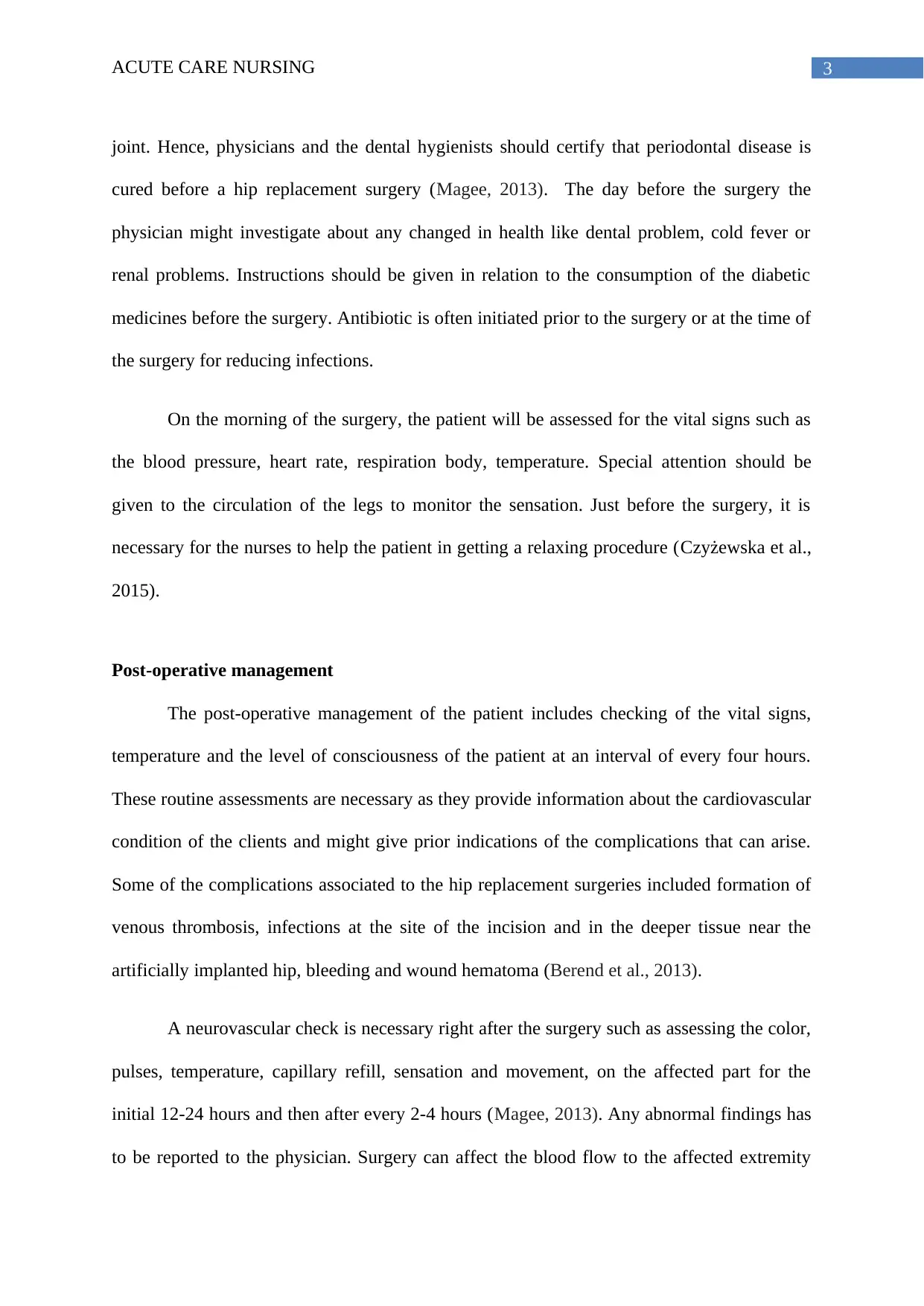
3ACUTE CARE NURSING
joint. Hence, physicians and the dental hygienists should certify that periodontal disease is
cured before a hip replacement surgery (Magee, 2013). The day before the surgery the
physician might investigate about any changed in health like dental problem, cold fever or
renal problems. Instructions should be given in relation to the consumption of the diabetic
medicines before the surgery. Antibiotic is often initiated prior to the surgery or at the time of
the surgery for reducing infections.
On the morning of the surgery, the patient will be assessed for the vital signs such as
the blood pressure, heart rate, respiration body, temperature. Special attention should be
given to the circulation of the legs to monitor the sensation. Just before the surgery, it is
necessary for the nurses to help the patient in getting a relaxing procedure (Czyżewska et al.,
2015).
Post-operative management
The post-operative management of the patient includes checking of the vital signs,
temperature and the level of consciousness of the patient at an interval of every four hours.
These routine assessments are necessary as they provide information about the cardiovascular
condition of the clients and might give prior indications of the complications that can arise.
Some of the complications associated to the hip replacement surgeries included formation of
venous thrombosis, infections at the site of the incision and in the deeper tissue near the
artificially implanted hip, bleeding and wound hematoma (Berend et al., 2013).
A neurovascular check is necessary right after the surgery such as assessing the color,
pulses, temperature, capillary refill, sensation and movement, on the affected part for the
initial 12-24 hours and then after every 2-4 hours (Magee, 2013). Any abnormal findings has
to be reported to the physician. Surgery can affect the blood flow to the affected extremity
joint. Hence, physicians and the dental hygienists should certify that periodontal disease is
cured before a hip replacement surgery (Magee, 2013). The day before the surgery the
physician might investigate about any changed in health like dental problem, cold fever or
renal problems. Instructions should be given in relation to the consumption of the diabetic
medicines before the surgery. Antibiotic is often initiated prior to the surgery or at the time of
the surgery for reducing infections.
On the morning of the surgery, the patient will be assessed for the vital signs such as
the blood pressure, heart rate, respiration body, temperature. Special attention should be
given to the circulation of the legs to monitor the sensation. Just before the surgery, it is
necessary for the nurses to help the patient in getting a relaxing procedure (Czyżewska et al.,
2015).
Post-operative management
The post-operative management of the patient includes checking of the vital signs,
temperature and the level of consciousness of the patient at an interval of every four hours.
These routine assessments are necessary as they provide information about the cardiovascular
condition of the clients and might give prior indications of the complications that can arise.
Some of the complications associated to the hip replacement surgeries included formation of
venous thrombosis, infections at the site of the incision and in the deeper tissue near the
artificially implanted hip, bleeding and wound hematoma (Berend et al., 2013).
A neurovascular check is necessary right after the surgery such as assessing the color,
pulses, temperature, capillary refill, sensation and movement, on the affected part for the
initial 12-24 hours and then after every 2-4 hours (Magee, 2013). Any abnormal findings has
to be reported to the physician. Surgery can affect the blood flow to the affected extremity
Secure Best Marks with AI Grader
Need help grading? Try our AI Grader for instant feedback on your assignments.
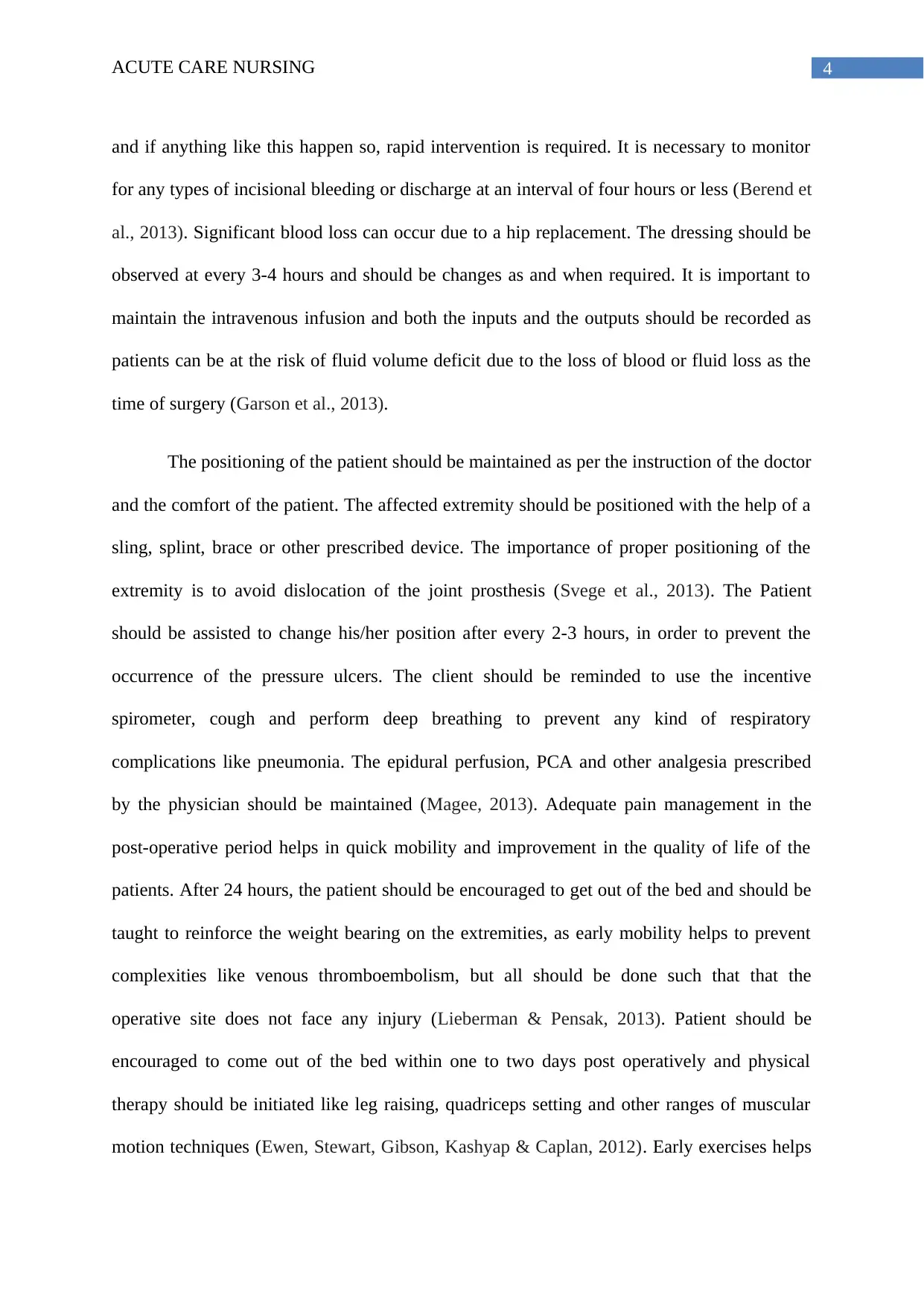
4ACUTE CARE NURSING
and if anything like this happen so, rapid intervention is required. It is necessary to monitor
for any types of incisional bleeding or discharge at an interval of four hours or less (Berend et
al., 2013). Significant blood loss can occur due to a hip replacement. The dressing should be
observed at every 3-4 hours and should be changes as and when required. It is important to
maintain the intravenous infusion and both the inputs and the outputs should be recorded as
patients can be at the risk of fluid volume deficit due to the loss of blood or fluid loss as the
time of surgery (Garson et al., 2013).
The positioning of the patient should be maintained as per the instruction of the doctor
and the comfort of the patient. The affected extremity should be positioned with the help of a
sling, splint, brace or other prescribed device. The importance of proper positioning of the
extremity is to avoid dislocation of the joint prosthesis (Svege et al., 2013). The Patient
should be assisted to change his/her position after every 2-3 hours, in order to prevent the
occurrence of the pressure ulcers. The client should be reminded to use the incentive
spirometer, cough and perform deep breathing to prevent any kind of respiratory
complications like pneumonia. The epidural perfusion, PCA and other analgesia prescribed
by the physician should be maintained (Magee, 2013). Adequate pain management in the
post-operative period helps in quick mobility and improvement in the quality of life of the
patients. After 24 hours, the patient should be encouraged to get out of the bed and should be
taught to reinforce the weight bearing on the extremities, as early mobility helps to prevent
complexities like venous thromboembolism, but all should be done such that that the
operative site does not face any injury (Lieberman & Pensak, 2013). Patient should be
encouraged to come out of the bed within one to two days post operatively and physical
therapy should be initiated like leg raising, quadriceps setting and other ranges of muscular
motion techniques (Ewen, Stewart, Gibson, Kashyap & Caplan, 2012). Early exercises helps
and if anything like this happen so, rapid intervention is required. It is necessary to monitor
for any types of incisional bleeding or discharge at an interval of four hours or less (Berend et
al., 2013). Significant blood loss can occur due to a hip replacement. The dressing should be
observed at every 3-4 hours and should be changes as and when required. It is important to
maintain the intravenous infusion and both the inputs and the outputs should be recorded as
patients can be at the risk of fluid volume deficit due to the loss of blood or fluid loss as the
time of surgery (Garson et al., 2013).
The positioning of the patient should be maintained as per the instruction of the doctor
and the comfort of the patient. The affected extremity should be positioned with the help of a
sling, splint, brace or other prescribed device. The importance of proper positioning of the
extremity is to avoid dislocation of the joint prosthesis (Svege et al., 2013). The Patient
should be assisted to change his/her position after every 2-3 hours, in order to prevent the
occurrence of the pressure ulcers. The client should be reminded to use the incentive
spirometer, cough and perform deep breathing to prevent any kind of respiratory
complications like pneumonia. The epidural perfusion, PCA and other analgesia prescribed
by the physician should be maintained (Magee, 2013). Adequate pain management in the
post-operative period helps in quick mobility and improvement in the quality of life of the
patients. After 24 hours, the patient should be encouraged to get out of the bed and should be
taught to reinforce the weight bearing on the extremities, as early mobility helps to prevent
complexities like venous thromboembolism, but all should be done such that that the
operative site does not face any injury (Lieberman & Pensak, 2013). Patient should be
encouraged to come out of the bed within one to two days post operatively and physical
therapy should be initiated like leg raising, quadriceps setting and other ranges of muscular
motion techniques (Ewen, Stewart, Gibson, Kashyap & Caplan, 2012). Early exercises helps
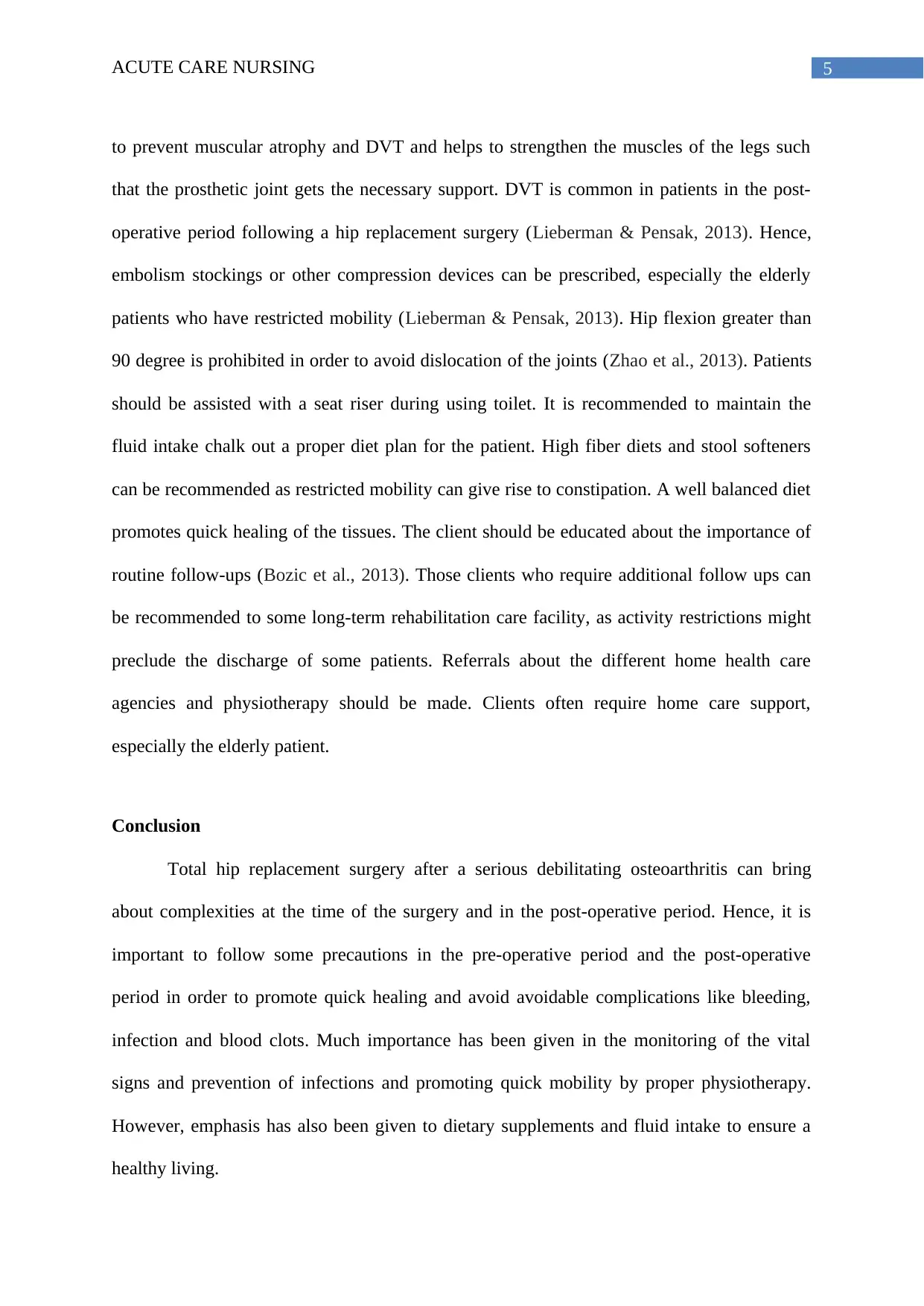
5ACUTE CARE NURSING
to prevent muscular atrophy and DVT and helps to strengthen the muscles of the legs such
that the prosthetic joint gets the necessary support. DVT is common in patients in the post-
operative period following a hip replacement surgery (Lieberman & Pensak, 2013). Hence,
embolism stockings or other compression devices can be prescribed, especially the elderly
patients who have restricted mobility (Lieberman & Pensak, 2013). Hip flexion greater than
90 degree is prohibited in order to avoid dislocation of the joints (Zhao et al., 2013). Patients
should be assisted with a seat riser during using toilet. It is recommended to maintain the
fluid intake chalk out a proper diet plan for the patient. High fiber diets and stool softeners
can be recommended as restricted mobility can give rise to constipation. A well balanced diet
promotes quick healing of the tissues. The client should be educated about the importance of
routine follow-ups (Bozic et al., 2013). Those clients who require additional follow ups can
be recommended to some long-term rehabilitation care facility, as activity restrictions might
preclude the discharge of some patients. Referrals about the different home health care
agencies and physiotherapy should be made. Clients often require home care support,
especially the elderly patient.
Conclusion
Total hip replacement surgery after a serious debilitating osteoarthritis can bring
about complexities at the time of the surgery and in the post-operative period. Hence, it is
important to follow some precautions in the pre-operative period and the post-operative
period in order to promote quick healing and avoid avoidable complications like bleeding,
infection and blood clots. Much importance has been given in the monitoring of the vital
signs and prevention of infections and promoting quick mobility by proper physiotherapy.
However, emphasis has also been given to dietary supplements and fluid intake to ensure a
healthy living.
to prevent muscular atrophy and DVT and helps to strengthen the muscles of the legs such
that the prosthetic joint gets the necessary support. DVT is common in patients in the post-
operative period following a hip replacement surgery (Lieberman & Pensak, 2013). Hence,
embolism stockings or other compression devices can be prescribed, especially the elderly
patients who have restricted mobility (Lieberman & Pensak, 2013). Hip flexion greater than
90 degree is prohibited in order to avoid dislocation of the joints (Zhao et al., 2013). Patients
should be assisted with a seat riser during using toilet. It is recommended to maintain the
fluid intake chalk out a proper diet plan for the patient. High fiber diets and stool softeners
can be recommended as restricted mobility can give rise to constipation. A well balanced diet
promotes quick healing of the tissues. The client should be educated about the importance of
routine follow-ups (Bozic et al., 2013). Those clients who require additional follow ups can
be recommended to some long-term rehabilitation care facility, as activity restrictions might
preclude the discharge of some patients. Referrals about the different home health care
agencies and physiotherapy should be made. Clients often require home care support,
especially the elderly patient.
Conclusion
Total hip replacement surgery after a serious debilitating osteoarthritis can bring
about complexities at the time of the surgery and in the post-operative period. Hence, it is
important to follow some precautions in the pre-operative period and the post-operative
period in order to promote quick healing and avoid avoidable complications like bleeding,
infection and blood clots. Much importance has been given in the monitoring of the vital
signs and prevention of infections and promoting quick mobility by proper physiotherapy.
However, emphasis has also been given to dietary supplements and fluid intake to ensure a
healthy living.

6ACUTE CARE NURSING
References
Bandholm, T., & Kehlet, H. (2012). Physiotherapy exercise after fast-track total hip and knee
arthroplasty: time for reconsideration?. Archives of physical medicine and
rehabilitation, 93(7), 1292-1294. https://doi.org/10.1016/j.apmr.2012.02.014
Berend, K. R., Lombardi, A. V., Morris, M. J., Bergeson, A. G., Adams, J. B., & Sneller, M.
A. (2013). Two-stage treatment of hip periprosthetic joint infection is associated with
a high rate of infection control but high mortality. Clinical Orthopaedics and Related
Research®, 471(2), 510-518. https://doi.org/10.1007/s11999-012-2595-x
Bozic, K. J., Lau, E., Kurtz, S., Ong, K., Rubash, H., Vail, T. P., & Berry, D. J. (2012).
Patient-related risk factors for periprosthetic joint infection and postoperative
mortality following total hip arthroplasty in Medicare patients. JBJS, 94(9), 794-800.
doi: 10.2106/JBJS.K.00072
Czyżewska, A., Glinkowski, W. M., Walesiak, K., Krawczak, K., Cabaj, D., & Górecki, A.
(2014). Effects of preoperative physiotherapy in hip osteoarthritis patients awaiting
total hip replacement. Archives of Medical Science : AMS, 10(5), 985–991.
http://doi.org/10.5114/aoms.2014.46218
Ewen, A. M., Stewart, S., Gibson, A. S. C., Kashyap, S. N., & Caplan, N. (2012). Post-
operative gait analysis in total hip replacement patients—a review of current literature
References
Bandholm, T., & Kehlet, H. (2012). Physiotherapy exercise after fast-track total hip and knee
arthroplasty: time for reconsideration?. Archives of physical medicine and
rehabilitation, 93(7), 1292-1294. https://doi.org/10.1016/j.apmr.2012.02.014
Berend, K. R., Lombardi, A. V., Morris, M. J., Bergeson, A. G., Adams, J. B., & Sneller, M.
A. (2013). Two-stage treatment of hip periprosthetic joint infection is associated with
a high rate of infection control but high mortality. Clinical Orthopaedics and Related
Research®, 471(2), 510-518. https://doi.org/10.1007/s11999-012-2595-x
Bozic, K. J., Lau, E., Kurtz, S., Ong, K., Rubash, H., Vail, T. P., & Berry, D. J. (2012).
Patient-related risk factors for periprosthetic joint infection and postoperative
mortality following total hip arthroplasty in Medicare patients. JBJS, 94(9), 794-800.
doi: 10.2106/JBJS.K.00072
Czyżewska, A., Glinkowski, W. M., Walesiak, K., Krawczak, K., Cabaj, D., & Górecki, A.
(2014). Effects of preoperative physiotherapy in hip osteoarthritis patients awaiting
total hip replacement. Archives of Medical Science : AMS, 10(5), 985–991.
http://doi.org/10.5114/aoms.2014.46218
Ewen, A. M., Stewart, S., Gibson, A. S. C., Kashyap, S. N., & Caplan, N. (2012). Post-
operative gait analysis in total hip replacement patients—a review of current literature
Paraphrase This Document
Need a fresh take? Get an instant paraphrase of this document with our AI Paraphraser
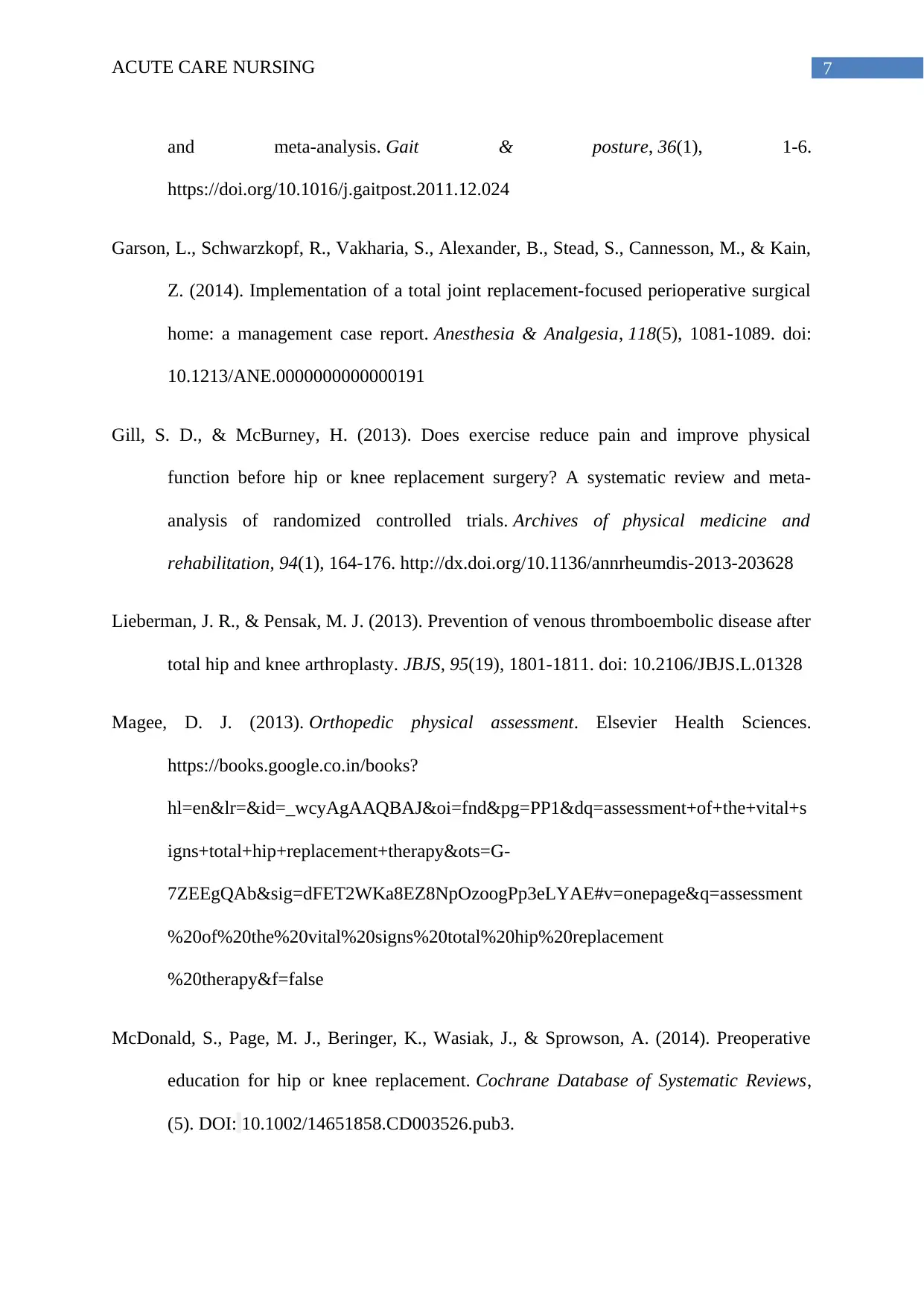
7ACUTE CARE NURSING
and meta-analysis. Gait & posture, 36(1), 1-6.
https://doi.org/10.1016/j.gaitpost.2011.12.024
Garson, L., Schwarzkopf, R., Vakharia, S., Alexander, B., Stead, S., Cannesson, M., & Kain,
Z. (2014). Implementation of a total joint replacement-focused perioperative surgical
home: a management case report. Anesthesia & Analgesia, 118(5), 1081-1089. doi:
10.1213/ANE.0000000000000191
Gill, S. D., & McBurney, H. (2013). Does exercise reduce pain and improve physical
function before hip or knee replacement surgery? A systematic review and meta-
analysis of randomized controlled trials. Archives of physical medicine and
rehabilitation, 94(1), 164-176. http://dx.doi.org/10.1136/annrheumdis-2013-203628
Lieberman, J. R., & Pensak, M. J. (2013). Prevention of venous thromboembolic disease after
total hip and knee arthroplasty. JBJS, 95(19), 1801-1811. doi: 10.2106/JBJS.L.01328
Magee, D. J. (2013). Orthopedic physical assessment. Elsevier Health Sciences.
https://books.google.co.in/books?
hl=en&lr=&id=_wcyAgAAQBAJ&oi=fnd&pg=PP1&dq=assessment+of+the+vital+s
igns+total+hip+replacement+therapy&ots=G-
7ZEEgQAb&sig=dFET2WKa8EZ8NpOzoogPp3eLYAE#v=onepage&q=assessment
%20of%20the%20vital%20signs%20total%20hip%20replacement
%20therapy&f=false
McDonald, S., Page, M. J., Beringer, K., Wasiak, J., & Sprowson, A. (2014). Preoperative
education for hip or knee replacement. Cochrane Database of Systematic Reviews,
(5). DOI: 10.1002/14651858.CD003526.pub3.
and meta-analysis. Gait & posture, 36(1), 1-6.
https://doi.org/10.1016/j.gaitpost.2011.12.024
Garson, L., Schwarzkopf, R., Vakharia, S., Alexander, B., Stead, S., Cannesson, M., & Kain,
Z. (2014). Implementation of a total joint replacement-focused perioperative surgical
home: a management case report. Anesthesia & Analgesia, 118(5), 1081-1089. doi:
10.1213/ANE.0000000000000191
Gill, S. D., & McBurney, H. (2013). Does exercise reduce pain and improve physical
function before hip or knee replacement surgery? A systematic review and meta-
analysis of randomized controlled trials. Archives of physical medicine and
rehabilitation, 94(1), 164-176. http://dx.doi.org/10.1136/annrheumdis-2013-203628
Lieberman, J. R., & Pensak, M. J. (2013). Prevention of venous thromboembolic disease after
total hip and knee arthroplasty. JBJS, 95(19), 1801-1811. doi: 10.2106/JBJS.L.01328
Magee, D. J. (2013). Orthopedic physical assessment. Elsevier Health Sciences.
https://books.google.co.in/books?
hl=en&lr=&id=_wcyAgAAQBAJ&oi=fnd&pg=PP1&dq=assessment+of+the+vital+s
igns+total+hip+replacement+therapy&ots=G-
7ZEEgQAb&sig=dFET2WKa8EZ8NpOzoogPp3eLYAE#v=onepage&q=assessment
%20of%20the%20vital%20signs%20total%20hip%20replacement
%20therapy&f=false
McDonald, S., Page, M. J., Beringer, K., Wasiak, J., & Sprowson, A. (2014). Preoperative
education for hip or knee replacement. Cochrane Database of Systematic Reviews,
(5). DOI: 10.1002/14651858.CD003526.pub3.
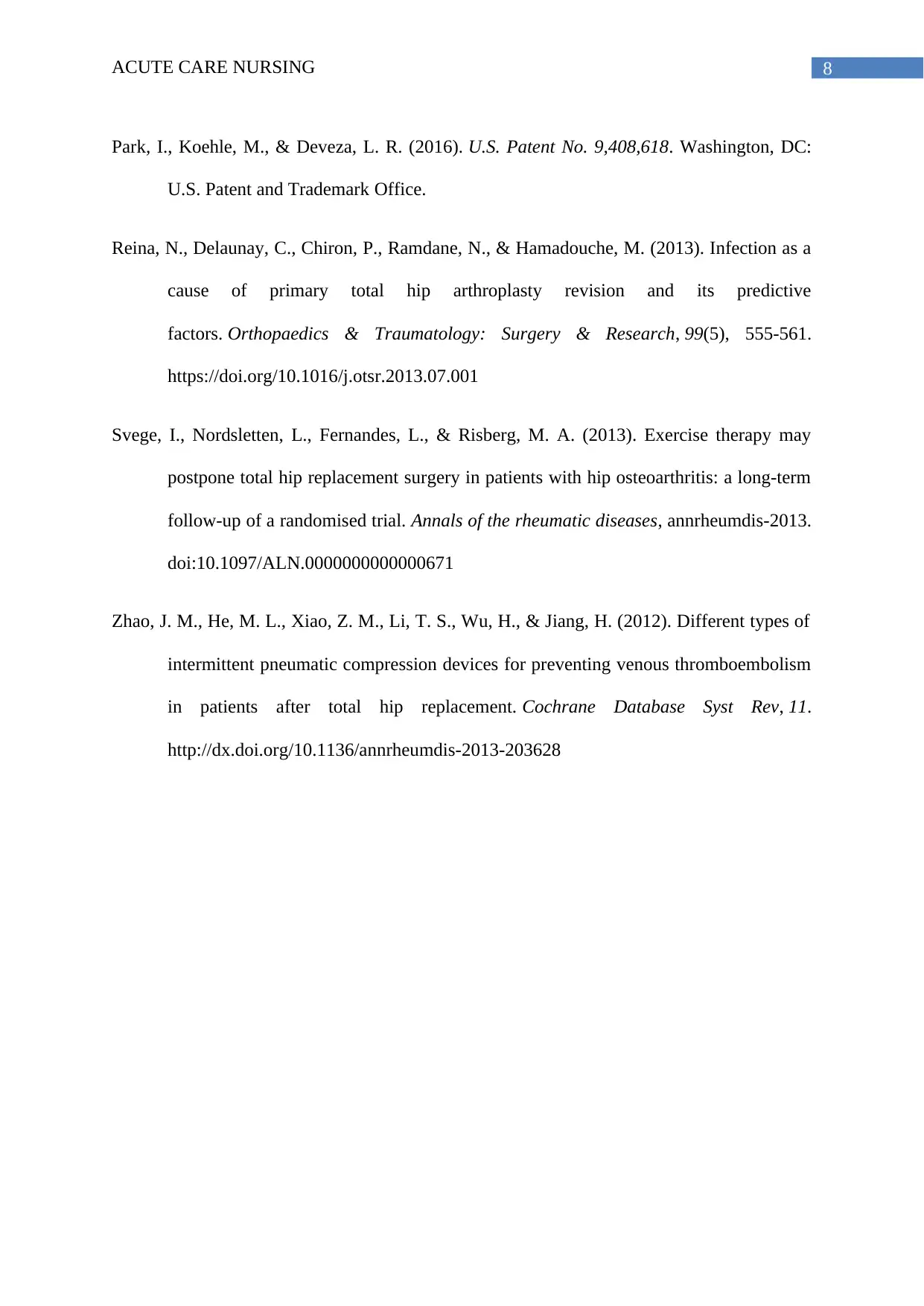
8ACUTE CARE NURSING
Park, I., Koehle, M., & Deveza, L. R. (2016). U.S. Patent No. 9,408,618. Washington, DC:
U.S. Patent and Trademark Office.
Reina, N., Delaunay, C., Chiron, P., Ramdane, N., & Hamadouche, M. (2013). Infection as a
cause of primary total hip arthroplasty revision and its predictive
factors. Orthopaedics & Traumatology: Surgery & Research, 99(5), 555-561.
https://doi.org/10.1016/j.otsr.2013.07.001
Svege, I., Nordsletten, L., Fernandes, L., & Risberg, M. A. (2013). Exercise therapy may
postpone total hip replacement surgery in patients with hip osteoarthritis: a long-term
follow-up of a randomised trial. Annals of the rheumatic diseases, annrheumdis-2013.
doi:10.1097/ALN.0000000000000671
Zhao, J. M., He, M. L., Xiao, Z. M., Li, T. S., Wu, H., & Jiang, H. (2012). Different types of
intermittent pneumatic compression devices for preventing venous thromboembolism
in patients after total hip replacement. Cochrane Database Syst Rev, 11.
http://dx.doi.org/10.1136/annrheumdis-2013-203628
Park, I., Koehle, M., & Deveza, L. R. (2016). U.S. Patent No. 9,408,618. Washington, DC:
U.S. Patent and Trademark Office.
Reina, N., Delaunay, C., Chiron, P., Ramdane, N., & Hamadouche, M. (2013). Infection as a
cause of primary total hip arthroplasty revision and its predictive
factors. Orthopaedics & Traumatology: Surgery & Research, 99(5), 555-561.
https://doi.org/10.1016/j.otsr.2013.07.001
Svege, I., Nordsletten, L., Fernandes, L., & Risberg, M. A. (2013). Exercise therapy may
postpone total hip replacement surgery in patients with hip osteoarthritis: a long-term
follow-up of a randomised trial. Annals of the rheumatic diseases, annrheumdis-2013.
doi:10.1097/ALN.0000000000000671
Zhao, J. M., He, M. L., Xiao, Z. M., Li, T. S., Wu, H., & Jiang, H. (2012). Different types of
intermittent pneumatic compression devices for preventing venous thromboembolism
in patients after total hip replacement. Cochrane Database Syst Rev, 11.
http://dx.doi.org/10.1136/annrheumdis-2013-203628
1 out of 9
Related Documents
Your All-in-One AI-Powered Toolkit for Academic Success.
+13062052269
info@desklib.com
Available 24*7 on WhatsApp / Email
![[object Object]](/_next/static/media/star-bottom.7253800d.svg)
Unlock your academic potential
© 2024 | Zucol Services PVT LTD | All rights reserved.





